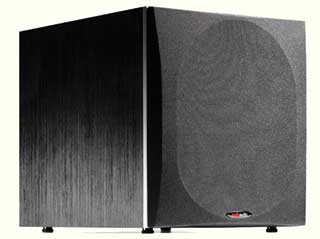|
Introduction
Founded by Matthew Polk and George Klopfer in 1972, Polk Audio is
headquartered in Baltimore, Maryland.
Polk Audio holds over 45 patents for
advances in loudspeaker design and technology. Their products are distributed
throughout the U.S. and Canada and in over 50 other countries. So, in other
words, this is a big company.
Responding to consumer demand for higher performance bass, Polk Audio has been
steadily improving its line of home theater subwoofers with high excursion
drivers, bigger enclosures, slot porting, and powerful digital BASH amps. The
505 is second in size for the subwoofer line, with the PSW1000 being the
largest.
The
Design
The PSW505 is a bass reflex design, with a front-firing woofer and rear-firing
slot vent. The slot vent is 12” wide, 1.25” high, and 13” deep, with a
smoothed edge transition to the rear faceplate. The internal surface area of
the slot vent is about 15 square inches; about the same as having two 3” round
ports. A close-mic sweep of the woofer revealed an enclosure tuning frequency
of 35 Hz.
The 12” driver features a huge foam surround, and a polymer
composite cone with an inverted dust cap. The driver mounting plate is covered
with a decorative rubberized foam strip, so I didn't attempt to remove the
woofer.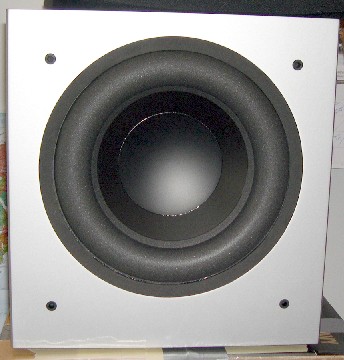
The external dimensions, including the feet, grille, and amp controls, are
approximately 16-1/8" high, 15-1/8" wide, and 18-3/16" deep. The sub weighs
about 40 pounds uncrated. The MDF cabinet interior is a bit unique, using the
top of the slot port for a horizontal brace, which in turn supports two
vertical braces. Polyfill is stuffed between the two vertical braces. There
are four hard plastic feet mounted on the bottom of the cabinet. I never heard
any vibration from the feet, and the sub didn't wander on my hard laminate
flooring.
The exterior is nicely finished in black wood grain vinyl, except for a black metal
faceplate in the rear, and a silver painted smooth MDF faceplate in the front. The grille
frame is made from injection molded plastic, and is attached to the cabinet
with a plastic pin and rubber grommet arrangement. I was really struck by the
impeccable fit and finish; I couldn't find any defects whatsoever. Polk Audio
clearly takes pride in its workmanship.
The Amplifier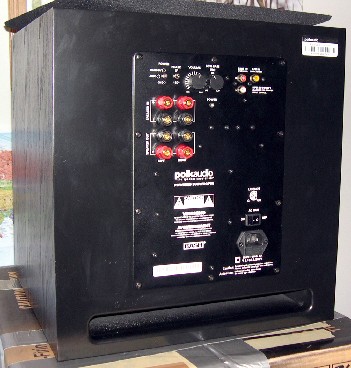 Features
Features
- On/Off Main Power Switch
- On/Auto-On/Stand-By (toggle)
- High Level Binding Post L/R Input/Output
- Low Level L/R RCA Filtered Inputs
- Low Level RCA Unfiltered Input
- Low Pass Filter (60-120 Hz, 4th order)
- Gain/Volume
- Phase Control (0/180 toggle)
- Detachable Power Cord
The digital BASH amp is rated at 300 watts continuous, and 460 watts peak with
program material. The control layout is logical, and the toggle switches and
rotary knobs have a quality feel and smooth operation. All major amp plate
penetrations are sealed with glue to prevent air leaks. The auto-on circuit
was easy to initialize at low volumes. If no signal is present, there is a
several minute delay before the amp shuts back off.
On the Bench
Setup: All objective tests were conducted with the microphone on the ground,
facing the subwoofer, at a distance of 2 meters from the width and depth
center point. The subwoofer was rotated so the driver and vent were both at a
45 degree angle to the microphone. I used the low level unfiltered input
(which bypasses the low pass filter), and set the phase control to 1800 (this resulted in a non-inverted impulse response).
Frequency Response: A short-duration (about 1.5 seconds), digitally
synthesized logarithmic sine sweep was used to evaluate the frequency response
of the subwoofer. The PSW505 frequency response measured 35 Hz -142
Hz ± 3 dB.
Peak Dynamic Output: This test measures how loud the subwoofer can play across its pass band with a short-duration signal representative of typical music and movie transients. Frequency response sweeps were conducted at progressively louder (2 dB increments) levels until dynamic compression was noted. The green curve (midle curve in the graph shown below) represents the maximum uncompressed dynamic output of the PSW505, with 105 dB at 70 Hz, and 95 dB at 30 Hz. The next higher curve (purple) showed dynamic compression, and the test was subsequently terminated.
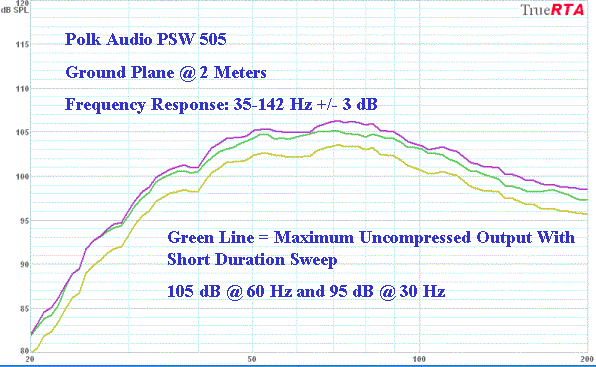
Power Compression: This test measures how loud the subwoofer can play across its pass band with a longer duration signal. A sustained bass passage in an action movie can create excessive heat in the voice coil, reducing longer term output capability. Power compression was evaluated with a slow reverse sine sweep from 100 Hz down to 10 Hz. Sweeps were conducted at progressively louder (2 dB increments) levels until power compression was observed. The PSW505 held steady up to the purple curve in the graph shown below, with 102 dB at 70 Hz, and 93 dB at 30 Hz. The next higher curve (gold) showed power compression, and the test was subsequently terminated.
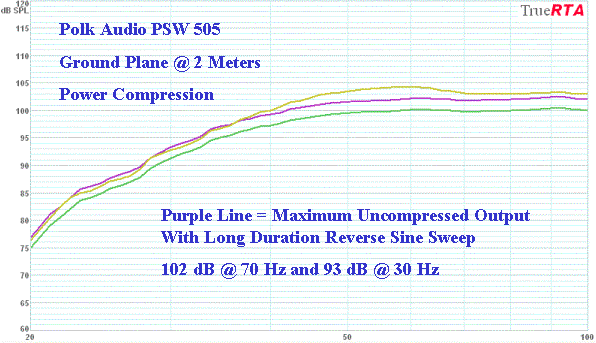
Total Harmonic Distortion (THD): Harmonic distortion occurs when multiples of
the fundamental signal are produced due to non-linear driver behavior. A
subwoofer with low THD will sound clean and distinct, especially at the
deepest frequencies. THD was evaluated with sine waves (about 5 seconds
duration), and was limited to approximately 10% unless otherwise noted. Clean
output from the Polk was low in the 20 Hz - 25 Hz region, but it performed
considerably better in the 32 Hz - 80 Hz regions.
| Frequency | SPL | THD |
| 20 Hz | 65.5 dB | 10-12% fluctuating |
| 22 Hz | 68.0 dB | 10-12% fluctuating |
| 25 Hz | 76.0 dB | 10.4% |
| 32 Hz | 90.2 dB | 10.5% |
| 40 Hz | 101.5 dB | 10.2 % |
| 50 Hz | 104.1 dB | 9.8% |
| 63 Hz | 105.9 dB | 10.1% |
| 80 Hz | 103.8 dB | 10.2% |
Bandwidth Linearity: Bandwidth linearity is
calculated by dividing the average distortion limited SPL by the maximum
distortion limited SPL, and expressing the result as a percentage. A score of
100% means the subwoofer exhibits perfect output linearity across a given
bandwidth.
| Bandwidth | Average SPL | Bandwidth Linearity |
| 20 Hz - 80 Hz | 89.4 dB | 84% |
| 22 Hz - 80 Hz | 92.8 dB | 88% |
| 25 Hz - 80 Hz | 96.9 dB | 92% |
Group Delay: A sufficiently large and abrupt phase shift may cause the
perception of time smearing at the affected frequencies. Group delay is used
to quantify this phenomenon, and was calculated from the phase response for
select music notes. The approximate audibility thresholds are based on
extrapolations of existing group delay audibility studies. Group
delay from the Polk 505 remained below the approximate audibility thresholds
at each tested frequency.
| Musical Note/Frequency | Group Delay | Approximate Audibility Threshold |
| F2 / 87 Hz | 0.5 ms | 15 ms |
| G1 / 49 Hz | 8 ms | 25 ms |
| C1 / 33 Hz | 14 ms | 35 ms |
| A0 / 27 Hz | 22 ms | 42 ms |
Impulse Response and Spectral Decay: The impulse response (black line) shows transient overshoot and system ringing for about 40 ms. Spectral decay was evaluated to the –35 dB mark, relative to the test volume. Several minor system resonances were noted in the 20-100 Hz bandwidth. The largest resonance dropped below the test floor after about 110 ms.
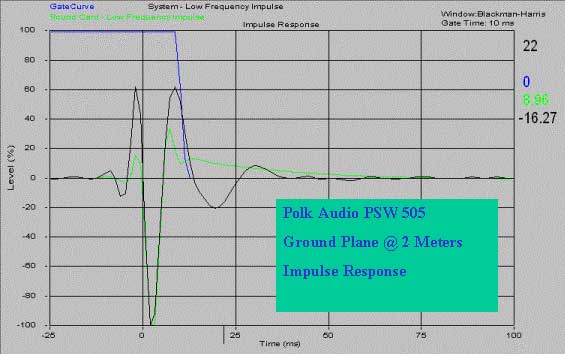
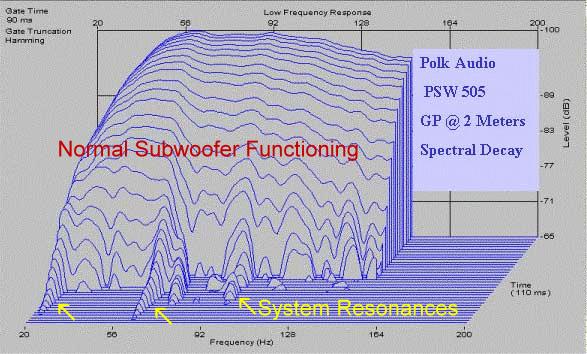
In-Room Frequency Response
To simulate a typical user setup, the PSW505 was placed in the front left
corner of my 2,000 ft3 home theater room. For digital bass management, all
speakers were set to Small, with a crossover of 80 Hz. The in-room FR was
measured at the primary listening position, about 11 feet from the subwoofer.
The in-room FR sweeps were processed through the pre/pro with only the main
speakers and the subwoofer operating. Setting the phase to 1800 provided the best results (00 resulted in obvious cancellation with the
mains near 80 Hz).
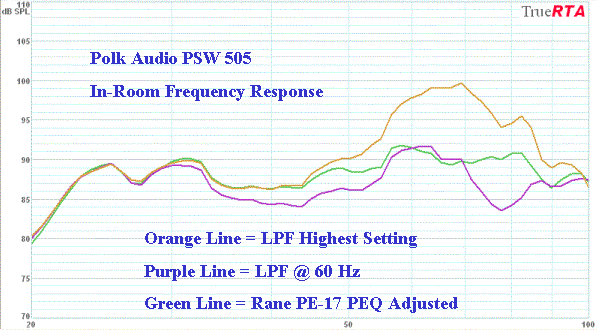
As expected, room gain helped considerably to improve deep extension, with the
Polk holding flat to about 25 Hz, and then dropping to –10 dB at 20 Hz. The
response also showed a pronounced peak in the 55 Hz - 90 Hz region (orange-gold
line in graph shown above).
This peak is the combined result of room acoustics, asymmetrical filters in
the digital bass management circuit, and the general shape of the
quasi-anechoic FR (which also plateaus in the 55 Hz - 90 Hz region).
I switched to a filtered line-level input on the PSW505, and experimented with
the low-pass filter in an attempt to eliminate the response peak. I obtained
the best results (purple line in the graph shown above) with the filter set around 60 Hz, but I wasn't
completely satisfied with the results, as I could still hear some noticeable
mid-bass droning.
I decided to use my Rane PE-17 parametric equalizer to optimize the in-room
response. Without much effort, I achieved an in-room FR of 23 Hz - 100 Hz ± 3 dB
(green line in graph above). The PSW505 now sounded much better, and I proceeded with the movie
and music evaluations.
Movies
I played several action-oriented DVDs, evaluating the PSW505 for dynamic
impact, sustained output capability, audible artifacts (muddiness,
compression, port chuffing, cone cry, rattling), and deep extension. My
overall subjective home theater ratings for the Polk provided in the table
below.
Evaluation Criteria Rating (1-5):
Dynamic Impact 3.00
Sustained Output 2.75
Audible Artifacts 2.25
Deep Extension 2.75
I selected The Day After Tomorrow for a more detailed demo. To set the
playback level, I increased the master volume until the Polk started to
exhibit audible artifacts on demanding passages, and then I backed off 2 dB. I
measured SPL peaks at the listening position with a sound meter set to
C-weighted fast and no correction factors.
The PSW505 generated some respectable sound pressure on the New York tidal
wave scene, but missed the infrasonic undercurrent which makes this scene so
gripping. The wave smashing into the building had good dynamics and extension.
The ultra deep moody bass during the storm simulation scene proved too
challenging for the PSW505, with cone cry and port chuffing evident. In
fairness, very few subwoofers can play this demanding scene with complete
justice, and the lack of masking noise makes it easy to hear any extension
deficiencies or artifacts. The 505 added credible foundation to the underwater
bus scene, omitting just a bit of the infrasonic decay after the ship stops
moving. The pick-up collision was well played, with solid impact.
| The Day After Tomorrow DTS 5.1 Master Volume –15 |
Time Stamp | Peak SPL |
| Tidal Wave Rolling | 0:48:50 | 98-100 dB |
| Wave Smashes Building | 0:50:54-0:51:03 | 104-105 dB |
| Computer Simulation of Storm | 0:52:06 | 87 dB |
| Ship Pushes Bus Underwater | 1:02:48-55 | 99-102 dB |
| Pick-Up Collides With Tanker | 1:18:46 | 102 dB |
Music
I evaluating the Polk on several music selections for balance, definition,
pitch, and coherence. My overall subjective music ratings for the PSW505 are
provided in the table below. Also provided below are some listening notes from
a few CDs.
Evaluation Criteria Rating (1-5)
Balance 3.25
Definition 2.75
Pitch 2.75
Coherence 2.75
1) The Nightfly – Donald Fagan, Warner Brothers Records (1982) High Resolution
DVD-A, 2002. I liked how the 505 handled this DVD. Bass guitar (even low E) and kick drum
were well played with pleasing balance and tonality.
2) Gladiator Soundtrack - Hans Zimmer, Decca Records, 2000. I would have
preferred more distinct separation of the deep, throbbing bass hits at the 6
minute mark of "Barbarian Horde". And the single deep note at the 8:57 mark only
had average definition and pitch. This challenging CD contains very deep
bass (below 30 Hz) that few subwoofers can play with complete justice.
3) Wildflowers – Tom Petty, Warner Brothers Records, 1994. "Crawling Back To
You" features a well recorded bass kick drum, and "It's Good To Be King" opens
with some hard tom strikes. The 505 sounded good on both songs, exhibiting
good tympanic character without much boom or overhang.
4) Los Lonely Boys - Or Music, LLC / Sony Music
Entertainment, 2003. The 505 had no trouble handling the aggressive electric
bass guitar work on this Latino rock CD, sounding natural with good
distinction of notes and solid extension on low E (about 40 Hz).
Conclusions
The PSW505 is an attractive subwoofer with excellent fit and finish. I liked
how the Polk performed on most popular music; it easily handled low E on the
bass guitar, kick drum, and tom strikes. In my mid-size home theater room, the
Polk belted out respectable sound pressure, and breezed through most
mid-bass movie passages, only falling short on the very deepest (below 30
Hz) material. Overall though, I think the PSW505 stacks up well against
its intended competition at nationwide retail chain stores.
- Ed Mullen -

